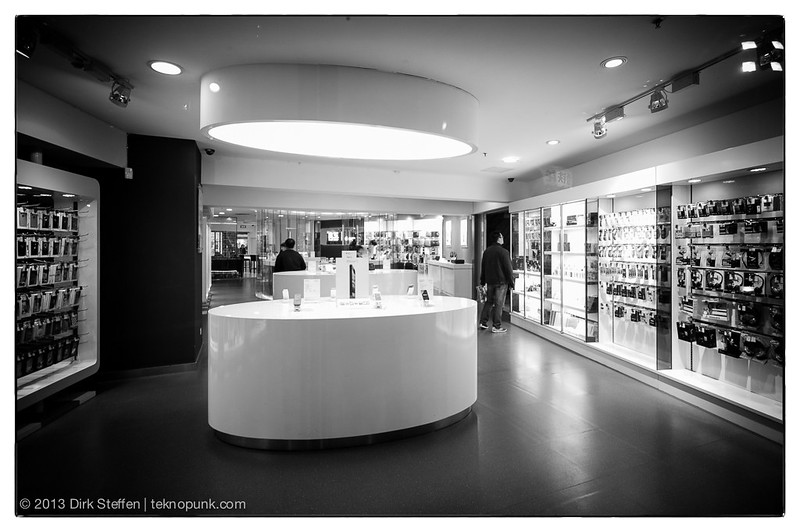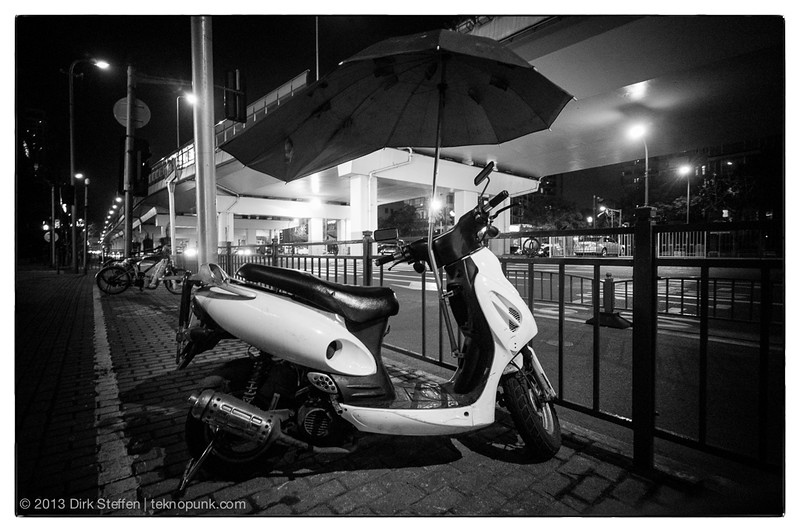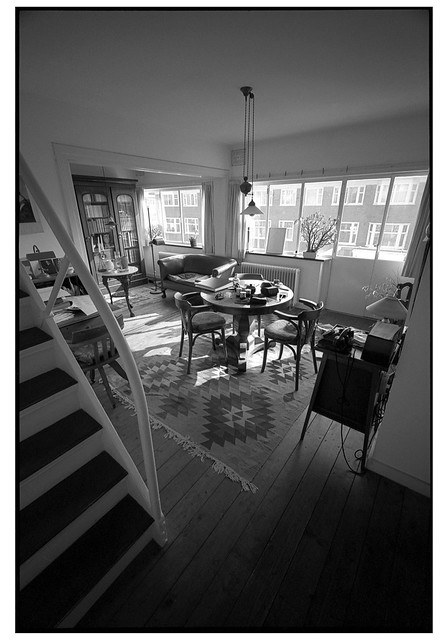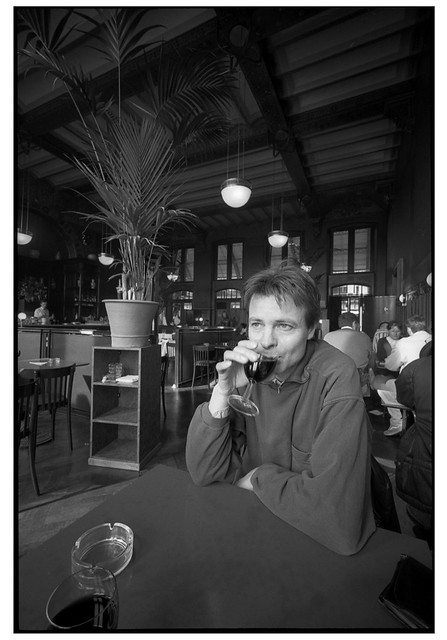menos
Mentor
I have been in a Hologon rush since some time and finally found my own sample.
I would love for anybody, who has any kind of knowledge, information or even a link, pictures from lenses, made with lenses to share here.
Don't hold back and share what you have!
As a place holder, here are a few shots made with a Contax G mount Hologon 16/8 on a Leica M Monochrom.
This lens has been converted in Germany to Leica M mount - I am trying to find details on it's history:

16 f8 Hologon - first shots - man on scooter by teknopunk.com, on Flickr

16 f8 Hologon - first shots - shop interior by teknopunk.com, on Flickr

16 f8 Hologon - first shots - weird umbrella scooter by teknopunk.com, on Flickr

16 f8 Hologon - first shots - bike by teknopunk.com, on Flickr
The interesting bit about this lens is, that it's M-mount conversion is unlike any others, I have seen in person or photos on the internet.
The massive brass M-mount's silver chrome finish actually matches exactly the lens satin chrome body.
It is not aftermarket screwed from the back to the lens body, as most conversions, one finds nowadays.
The lens mounts and un-mounts extremely smoothly and sits tight without any play on the digital M mount. For all purposes, it looks like a factory made Leica M-mount Hologon !
The shop owner stated the lens conversion being made in Germany. When I handled this lens in the shop, my first thought was "Does Carl Zeiss Germany do M-mount conversions?" But there is no knowledge about Carl Zeiss, converting the Contax G 16/8 Hologon to Leica M-mount.
I know, that German based Mr. Zörkendorfer did offer professional grade lens conversions of the 16/8 Hologon in Contax G to Leica M before this costly service was made commercially uninteresting with the introduction of the more practical and much, much less costly Cosina Voigtlander 15/4.5 Heliar.
If anybody of you has photos or descriptions of the Zörkendorfer converted Hologon's please share!
I would love for anybody, who has any kind of knowledge, information or even a link, pictures from lenses, made with lenses to share here.
Don't hold back and share what you have!
As a place holder, here are a few shots made with a Contax G mount Hologon 16/8 on a Leica M Monochrom.
This lens has been converted in Germany to Leica M mount - I am trying to find details on it's history:

16 f8 Hologon - first shots - man on scooter by teknopunk.com, on Flickr

16 f8 Hologon - first shots - shop interior by teknopunk.com, on Flickr

16 f8 Hologon - first shots - weird umbrella scooter by teknopunk.com, on Flickr

16 f8 Hologon - first shots - bike by teknopunk.com, on Flickr
The interesting bit about this lens is, that it's M-mount conversion is unlike any others, I have seen in person or photos on the internet.
The massive brass M-mount's silver chrome finish actually matches exactly the lens satin chrome body.
It is not aftermarket screwed from the back to the lens body, as most conversions, one finds nowadays.
The lens mounts and un-mounts extremely smoothly and sits tight without any play on the digital M mount. For all purposes, it looks like a factory made Leica M-mount Hologon !
The shop owner stated the lens conversion being made in Germany. When I handled this lens in the shop, my first thought was "Does Carl Zeiss Germany do M-mount conversions?" But there is no knowledge about Carl Zeiss, converting the Contax G 16/8 Hologon to Leica M-mount.
I know, that German based Mr. Zörkendorfer did offer professional grade lens conversions of the 16/8 Hologon in Contax G to Leica M before this costly service was made commercially uninteresting with the introduction of the more practical and much, much less costly Cosina Voigtlander 15/4.5 Heliar.
If anybody of you has photos or descriptions of the Zörkendorfer converted Hologon's please share!
rawhead
Established
Well, Mr. Tommy Oshima on Flickr has the Leica M version of the Hologon (15/8) and you can see some of his Hologon shots here:
http://www.flickr.com/search/?w=84717426@N00&q=hologon
I guess the Monocrhome is a great body to use it on since you don't have to worry about color funkiness near the edges of the frame!
http://www.flickr.com/search/?w=84717426@N00&q=hologon
I guess the Monocrhome is a great body to use it on since you don't have to worry about color funkiness near the edges of the frame!
rawhead
Established
Hmm, I was quite certain he had the M version but looking at his tags, it does seem like he has the same converted Contax version (16/8)… sorry my bad!
pgk
Well-known
Menos - you can go to: http://blogs.zeiss.com/photo/en/?p=1044 to find a link (below the second photo) to a downloadable pdf from Zeiss - near the end is some information on the Hologon.
menos
Mentor
Off to a nice start ;-)
Rawhead, I have found some of Mr. Oshima's Hologon photos after I bought my sample ;-) I really like, what he does.
That's a great read pgk - thanks for sharing here!
Here are two reads, I found interesting, when I did some read ups:
http://www.mir.com.my/rb/photograph...s/RF-Nikkor/Contax_RF/Zeiss-Hologon/index.htm
http://www.zeisshistorica.org/Glatzel.html
Dr. Erhard Glatzel is my new lens design hero!
Does anybody have any further insight how it came to the redesign of the original Hologon triplet to the improved 5 element design of the 16/8 Hologon, used for the Contax G system? Was Dr. Glatzel involved? The PDF article from the Zeiss blog hints on a "manufacturing trick" of retaining the 15/8 three element design, but easing manufacturing by splitting the unique central element into three cemented elements.
Rawhead, I have found some of Mr. Oshima's Hologon photos after I bought my sample ;-) I really like, what he does.
That's a great read pgk - thanks for sharing here!
Here are two reads, I found interesting, when I did some read ups:
http://www.mir.com.my/rb/photograph...s/RF-Nikkor/Contax_RF/Zeiss-Hologon/index.htm
http://www.zeisshistorica.org/Glatzel.html
Dr. Erhard Glatzel is my new lens design hero!
Does anybody have any further insight how it came to the redesign of the original Hologon triplet to the improved 5 element design of the 16/8 Hologon, used for the Contax G system? Was Dr. Glatzel involved? The PDF article from the Zeiss blog hints on a "manufacturing trick" of retaining the 15/8 three element design, but easing manufacturing by splitting the unique central element into three cemented elements.
pgk
Well-known
Dirk
You may find these interesting too:
http://www.digitaltruth.com/articles/lenscorrections.php
http://allphotolenses.com/lenses/item/c_348.html
You may find these interesting too:
http://www.digitaltruth.com/articles/lenscorrections.php
http://allphotolenses.com/lenses/item/c_348.html
kbg32
neo-romanticist
I worked in a camera shop many years ago and one of the Hologram camera kits passed through. This was the late 70s, early 80s, and it was very rare to see a whole box kit. Expensive! I have the one for the "G", but loathe to get it converted at this point.
menos
Mentor
Dirk
You may find these interesting too:
http://www.digitaltruth.com/articles/lenscorrections.php
http://allphotolenses.com/lenses/item/c_348.html
Thanks! nice to find the Zeiss data sheet among the links!
I worked in a camera shop many years ago and one of the Hologram camera kits passed through. This was the late 70s, early 80s, and it was very rare to see a whole box kit. Expensive! I have the one for the "G", but loathe to get it converted at this point.
I wouldn't convert it, when shooting a G body and liking it!
Here is another night shoot with the converted Hologon on a M Monochrom:

I like the shape of the flare as well - wonderful, how controlled the flare actually is with this lens!
enasniearth
Well-known
Hologon
Hologon
The hologon is the descendant of an older goertz lens , the Hypergon .
This was an extreme wide angle with two domed glass elements .
It had amazing coverage and sharpness for its time .
When Zeiss ikon was formed during the German depression , Zeiss ended up with their competeier goertz 's designs , the Hypergon and dagor were now part of Zeiss .
The original 15 mm f8 hologon was a modification of the goertz Hypergon with the addition of an hourglass shaped lens element between the two domed glass half spheres of the Hypergon . It's aperture was fixed at f 8 and
A graduated neutral density filter was provided to help with light falloff in the corners . This reduced the effective lens speed to f16 .
This lens was resurrected with the contax g series as a 16 mm f8 hologon
With a similar neutral density filter , this lens for the first time had a focus mount , the earlier hologon 15 f8 was fixed focus ( yes there was a very rare 15 mm f8 in Leica m mount that focused - it is so rare it's unlikely you will ever see one )
The original Hypergon was for large format and if I remember correctly the shortest focal length was 65 mm , it was an amazing lens for the year - 1900
I always wanted the 16 mm hologon on a contax g1 body , as a dedicated wide angle camera .
Hologon
The hologon is the descendant of an older goertz lens , the Hypergon .
This was an extreme wide angle with two domed glass elements .
It had amazing coverage and sharpness for its time .
When Zeiss ikon was formed during the German depression , Zeiss ended up with their competeier goertz 's designs , the Hypergon and dagor were now part of Zeiss .
The original 15 mm f8 hologon was a modification of the goertz Hypergon with the addition of an hourglass shaped lens element between the two domed glass half spheres of the Hypergon . It's aperture was fixed at f 8 and
A graduated neutral density filter was provided to help with light falloff in the corners . This reduced the effective lens speed to f16 .
This lens was resurrected with the contax g series as a 16 mm f8 hologon
With a similar neutral density filter , this lens for the first time had a focus mount , the earlier hologon 15 f8 was fixed focus ( yes there was a very rare 15 mm f8 in Leica m mount that focused - it is so rare it's unlikely you will ever see one )
The original Hypergon was for large format and if I remember correctly the shortest focal length was 65 mm , it was an amazing lens for the year - 1900
I always wanted the 16 mm hologon on a contax g1 body , as a dedicated wide angle camera .
Tom A
RFF Sponsor
I have had a couple of the original 15f8 Hologon's in M-mount. Production was around 400 units. It was a very interesting lens - but for anything but architectural work - it was problematic. The fall off is massive! The ND filter reduced the speed from f8 to f16, it was a hyper focal lens - and infinity was never really that sharp. The last one I had was crudely "hacked" from a Hologon camera - and had a large chip out of the rear element, which showed up quite distinctly.
When the VC Heliar came out, I got rid of it - and got a lens with less fall off, infinity focus and aperture from 3.5 to f22!!!!
When the VC Heliar came out, I got rid of it - and got a lens with less fall off, infinity focus and aperture from 3.5 to f22!!!!
back alley
IMAGES
Optics and Lenses - This forum is aimed towards the TECHNICAL side of photographic OPTICS and LENSES. There will be some overlap by camera/manufacturer, but this forum is for the heavy duty tech discussions. This is NOT the place to discuss a specific lens or lens line, do that in the appropriate forum. This is the forum to discuss optics or lenses in general, to learn about the tech behind the lenses and images. IF you have a question about a specific lens, post it in the forum about that type of camera, NOT HERE.
pgk
Well-known
Actually, to quote Sid Ray, one of my former lecturers, the hologon was a 'unique lens' and lenses bearing its name have appeared in several mounts . Whilst it can be discussed within the Zeiss forum, I'm far from convinced that many people interested in it or its properties, or indeed the other lenses with 'similar' properties will immediately think to view such information in this forum. However, it is more than viable to bring things around to a more diverse optical discussion.
As far as I can ascertain with a 110 degree field of view the Hologon represents the maximum 'low-distortion', rectilinear view which could be obtained from a symmetric design. Its central hour glass element is intriguing and it is this which seems to bestow the 'uniqueness' in its original incarnation. I wonder about the naming of the later Contax 'Hologon' lens as it really is a derivative design of greater complexity? Other symmetric designs such as the Super Angulon only reached about 90 degrees and of course modern complex (anything but symmetric) designs now exceed this but do so at the cost of sometimes significant distortion so could they really be considered to be 'near rectilinear lenses .
.
Having commented on all this, I have as yet to discover just how distortion free some of the symmetric designs actually are - I have a SA 21/3.4 which I must get around to testing The figures for the later Contax G mount Hologon are certainly impressive Later design including the Zeiss 15mm ZM, Leica WATE and Leica 18mm lenses show considerably much greater distortion. Ultra wide angle (bulky and complex design) offerings from dSLR manufacturers also show significant distortion figures.
As a photographer who often shoots images with the sea as a horizon at the top of the frame, I much prefer low distortion lenses. Unfortunately, digital sensors don't like the extreme angle of incidence from symmetric lenses so I'm always left with a trade-off, de-distorting using software, using by SA as a B&W lens or using software colour correction. No solution is ideal.
As far as I can ascertain with a 110 degree field of view the Hologon represents the maximum 'low-distortion', rectilinear view which could be obtained from a symmetric design. Its central hour glass element is intriguing and it is this which seems to bestow the 'uniqueness' in its original incarnation. I wonder about the naming of the later Contax 'Hologon' lens as it really is a derivative design of greater complexity? Other symmetric designs such as the Super Angulon only reached about 90 degrees and of course modern complex (anything but symmetric) designs now exceed this but do so at the cost of sometimes significant distortion so could they really be considered to be 'near rectilinear lenses
Having commented on all this, I have as yet to discover just how distortion free some of the symmetric designs actually are - I have a SA 21/3.4 which I must get around to testing The figures for the later Contax G mount Hologon are certainly impressive Later design including the Zeiss 15mm ZM, Leica WATE and Leica 18mm lenses show considerably much greater distortion. Ultra wide angle (bulky and complex design) offerings from dSLR manufacturers also show significant distortion figures.
As a photographer who often shoots images with the sea as a horizon at the top of the frame, I much prefer low distortion lenses. Unfortunately, digital sensors don't like the extreme angle of incidence from symmetric lenses so I'm always left with a trade-off, de-distorting using software, using by SA as a B&W lens or using software colour correction. No solution is ideal.
menos
Mentor
Thanks to the people, who kept this thread open and thanks to all of you, sharing interesting information about this unique lens design - be it on samples, you used or historic information.
As initially intended, this is not a thread, aimed at a specific lens or mount, hence my choice of placing this thread in the "Optics and Lenses" forum, as I hoped, that far more people, who know about this lens design will share information and photos.
I apologise, if this interfered with forum rules. I surely didn't make the choice of forum carelessly or intended to provoke. When opening the thread, I was sober as well.
If anybody of you has any information on these topics, I would be very glad to learn about:
- large format Hologon lenses and their design
- the actual manufacturing process of the unique central element in the original Zeiss Hologon
Tom, was that hacked Hologon by any chance the sample, Stephen has on his website?
Is there a history, hoe it came to this drastic conversion?
Is the original Hologon camera finder of the same design as the later finder designs?
As initially intended, this is not a thread, aimed at a specific lens or mount, hence my choice of placing this thread in the "Optics and Lenses" forum, as I hoped, that far more people, who know about this lens design will share information and photos.
I apologise, if this interfered with forum rules. I surely didn't make the choice of forum carelessly or intended to provoke. When opening the thread, I was sober as well.
If anybody of you has any information on these topics, I would be very glad to learn about:
- large format Hologon lenses and their design
- the actual manufacturing process of the unique central element in the original Zeiss Hologon
Tom, was that hacked Hologon by any chance the sample, Stephen has on his website?
Is there a history, hoe it came to this drastic conversion?
Is the original Hologon camera finder of the same design as the later finder designs?
Erik van Straten
Mentor
Contax G1, Hologon 16mm f/8, Tmax400.
Erik.

Erik.

Erik van Straten
Mentor
Contax G1, Hologon 16mm f/8, Tmax400.
Erik.

Erik.

menos
Mentor
Thanks for sharing Erik! I always liked your precise compositions - didn't know, you used a Hologon, which seems like an interesting lens in your hands.
I am looking forward to see more from you!
It is a great balance in the second frame!
Did you use the 4x gradation filter on these photographs or was this the naked lens?
I am looking forward to see more from you!
It is a great balance in the second frame!
Did you use the 4x gradation filter on these photographs or was this the naked lens?
mretina
Well-known
worth reminding that the original contarex hologon has a unique design of three elements in one group which really stretched its realisation capabilities, while the contax hologon consists of a more easily manageable 5 elements in three groups design, to reduce manufacturing costs.
Erik van Straten
Mentor
Dirk, these shots are taken just with the naked lens. I like shooting this lens with the G1, because the camera generates automatically the right exposure. The viewfinder is excellent too. It is a perfect landscape and architecture lens.
Erik.
Erik.
Erik van Straten
Mentor
It is a great portrait lens too. It gives the spectator the feeling he makes part of the scene.
Contax G1, Hologon 16mm f/8, Tmax400.
Erik.

Contax G1, Hologon 16mm f/8, Tmax400.
Erik.

Highway 61
Revisited
Very nice shots Erik, and your darn Art-Deco living-room chairs and table are just stunning pieces of furniture !
Share:
-
This site uses cookies to help personalise content, tailor your experience and to keep you logged in if you register.
By continuing to use this site, you are consenting to our use of cookies.

